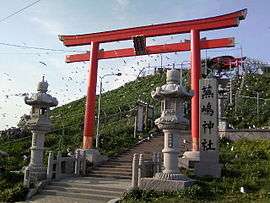Black-tailed gull
| Black-tailed gull | |
|---|---|
| | |
| Scientific classification | |
| Kingdom: | Animalia |
| Phylum: | Chordata |
| Class: | Aves |
| Order: | Charadriiformes |
| Family: | Laridae |
| Genus: | Larus |
| Species: | L. crassirostris |
| Binomial name | |
| Larus crassirostris Vieillot, 1818, Nagasaki | |
The black-tailed gull (Larus crassirostris) is a gull native to shorelines of East Asia.
Description
The black-tailed gull is medium-sized (46 cm), with a wingspan of 126–128 cm. It has yellow legs and a red and black spot at the end of the bill. Males and females have identical plumage and features, although males are larger in size than females.[2] This gull takes four years to reach full adult plumage.[3] As the name suggests, it has a black tail. The bird has a cat-like call, giving it its Japanese name — umineko, "sea cat", and Korean name — gwaeng-yi gull, which means "cat" gull. In Hachinohe they are one of the 100 Soundscapes of Japan.
Distribution and habitat
The species is resident to coastlines of the East China Sea, Japan, Manchuria and the Kuril Islands. It is a vagrant to Alaska and North America[4][5] and has been found in the Philippines.[6]
In Japan
The bird is common in Japan, nesting from Hokkaido to Western Kyushu. It has caused flights to be delayed at Haneda Airport in Tokyo.[7]
An enormous gathering of black-tailed gulls can be found at the Kabushima at Hachinohe, Aomori, Japan. A Shinto shrine was raised by fishermen in 1269 (though it has been rebuilt several times since) at which the black-tailed gull, is seen as a messenger of the goddess of the fishery. For over 700 years, the species has enjoyed reverence, feeding and protection from the local population. As a result, every summer, over 40,000 seagulls nest and raise their young in the grounds of the shrine and the surrounding island, which has been designated a National Natural Monument by the government of Japan. The seagulls are very tame and are a popular local tourist attraction.[8]
Around 5,000 birds also nest at Fumi-shima in Shimane Prefecture near Izumo Shrine,[9] and there is a large colony at Teuri Island in Hokkaido.[10]
In North America
A rare visitor to the United States, a black-tailed gull was spotted from Burlington, Vermont, in October 2005.[11] The bird has been spotted in Illinois several times.[12]
Ecology
The black-tailed gull feeds mainly on small fish, molluscs, crustaceans scraps and carrion. It often follows ships and commercial fishing fleets. It also steals food from other seabirds. It is a colonial nester, with colonies forming in mid-April. 2–3 eggs are laid by early June. Incubation lasts approximately 24 days.[13]
Images
 Black-tailed Gull, immature plumage
Black-tailed Gull, immature plumage Black-tailed Gull in Tokyo Bay
Black-tailed Gull in Tokyo Bay Black-tailed Gull in Hachinohe, Aomori
Black-tailed Gull in Hachinohe, Aomori Black-tailed Gulls at entrance to Kabushima Shrine
Black-tailed Gulls at entrance to Kabushima Shrine
References
- ↑ BirdLife International (2012). "Larus crassirostris". IUCN Red List of Threatened Species. Version 2013.2. International Union for Conservation of Nature. Retrieved 5 April 2016.
- ↑ Chochi, Michiyo; Niizuma, Yasuaki; Takagi, Masaoki (2002). "Sexual differences in the external measurements of Black-tailed Gulls breeding on Rishiri Island, Japan". Ornithological Science. 1 (2): 163–166.
- ↑ Doherty, Paul. "Black-tailed Gull: a photo essay". Surfbirds.com.
- ↑ Black-tailed Gull Audubon Field Guide Retrieved April 5, 2016
- ↑ "Black-tailed Gull". Birdweb.org.
- ↑ "Black-tailed Gull Larus crassirostris Factsheet". BirdLife International.
- ↑ Shooing away pesky birds never-ending job at Haneda November 22, 2003 The Japan Times Retrieved April 5, 2016
- ↑ Otaka, Tomoko. "Power spots and prehistory in beautiful Aomori Prefecture". The Japan Times.
- ↑ Bamforth, Chris (28 April 2006). "Here be the land of the gods". The Japan Times.
- ↑ Brazil, Mark (5 July 2000). "Migrants and vagrants under Teuri’s crags". The Japan Times.
- ↑ "Black-tailed Gull, Larus crassirostris, Charlotte Town Beach, Charlotte, Chittenden Co., VT, 23 October 2005".
- ↑ Swick, Nate. "Rare – Black-tailed Gull – Illinois January 11, 2016". American Birding Association blog.
- ↑ Boles, Walter (2009). Josep del Hoyo; Andrew Elliott; David A. Christie, eds. Handbook of Birds of the World, Volume 3. Barcelona, Spain: Lynx Edicions.
External links
| Wikimedia Commons has media related to Larus crassirostris. |
| Wikispecies has information related to: Larus crassirostris |
- Black-tailed Gulls at Kabushima – official site (in Japanese)
- Black-tailed Gull in California Black-tailed Gull information and Photos in California
- Video showing the gulls of Kabushima
- Video showing the gulls of Kabushima
